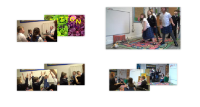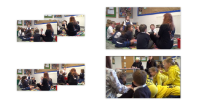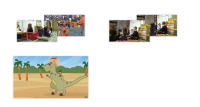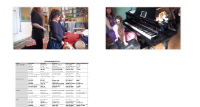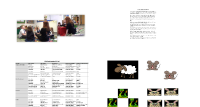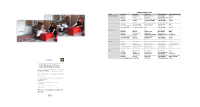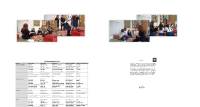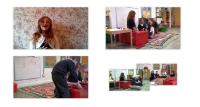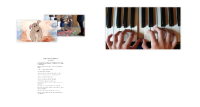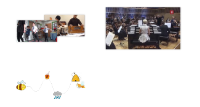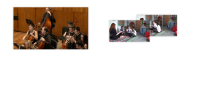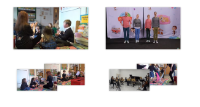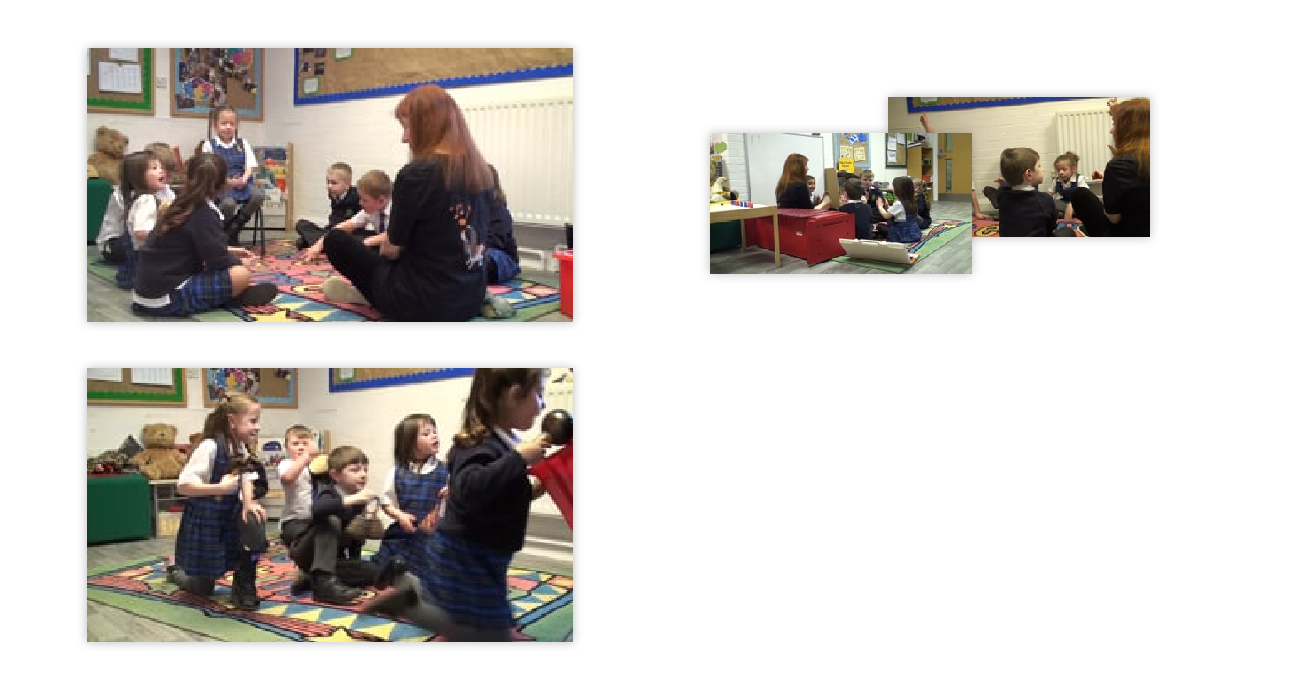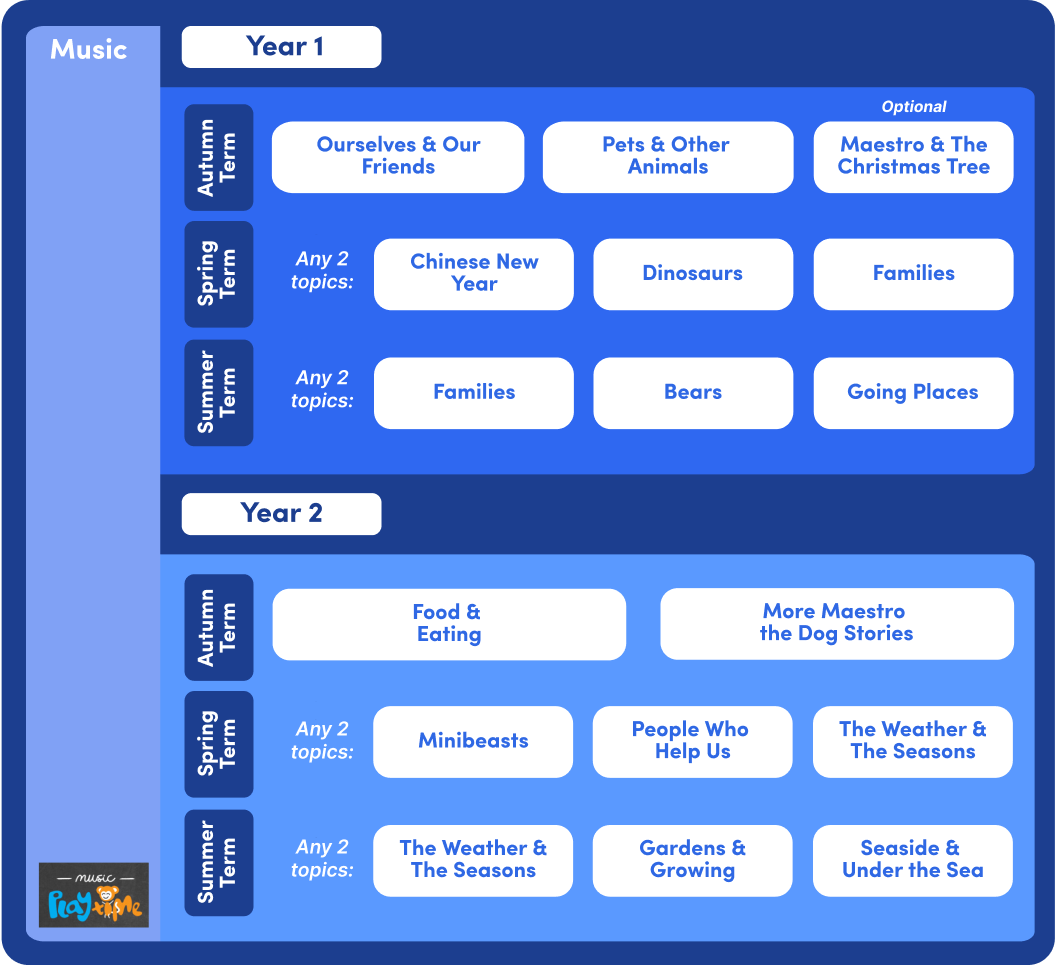Families Level: Key Stage 1
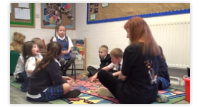
Who's in Your Family?
The point of the song is that we have all sorts of different families and that pets may be included too. I like children to use their solo sing-song voice without feeling unselfconscious so I never correct the pitch of the singing in this context. This was the first attempt, as you might have guessed!
My Granny Gave Me (rhythm, pulse, literacy link)
This is an alphabet game that can be played on successive days, choosing new letters each day. This game works well as an activity for a groups of three to five children but you could also do it in a big circle with the whole class if the children take turns. The children in the group take turns to say, 'My granny gave me a ....' so, before the game can start, ask for ideas about what granny 'gave me' and make sure every child has their phrase ready. Straight after the word such as Anteater, everyone in the group claps its rhythm then the next child continues with their words, without a pause. You may like to start with only three things that granny gave me, and then build up to four or five. The words needs to be rhythmical so tap the pulse on knees or use a drum to keep the pulse. After all the children in the group have said what granny gave them, they all say, 'And that's all!'
- Child 1 - My granny gave me an Anteater (clap clap clap)
- Child 2 - My granny gave me a Bear (clap)
- Child 3 - My granny gave me a Cam-el (clap clap)
- Child 4 - My granny gave me a Duck (clap)
- Child 5 - My granny gave me an El-e-phant (clap clap clap)
- Child 1 - My Granny gave me an Anteater (clap clap clap), Child 2 - bear (clap), Child 3 - Cam-el (clap clap), Child 4 - Duck (clap), Child 5 - El-e-phant (clap clap clap)
- Everyone - And that's all!
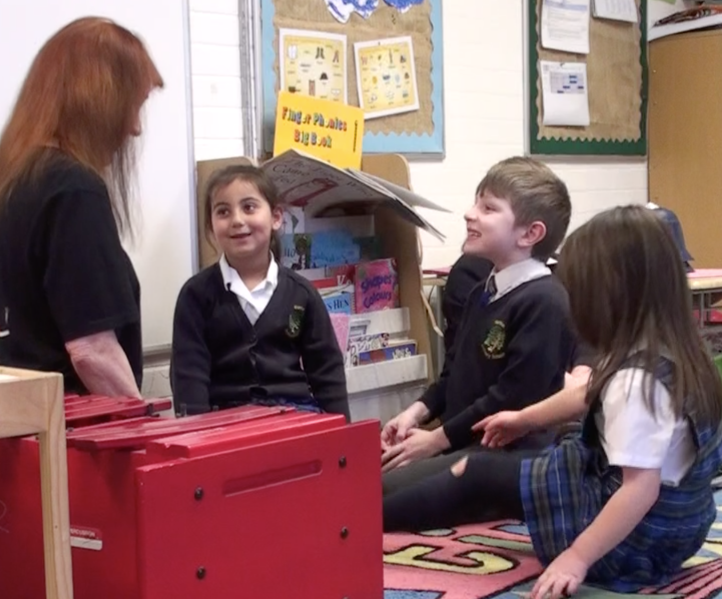
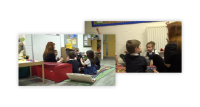
Ye Canna Shove Your Granny Off a Bus!
I soon remembered this song with Amitie's help! This video demonstrates one of the reasons why I tend not to use accompaniments for singing - the spontaneity here is delightful and the moment could not have waited while we found an accompaniment!
Grandma's Action Chant
It's best to teach chants by rote, but some children may enjoy reading the words at first. There are actions for each line.
- These are grandma’s glasses (make circles around eyes with fingers)
- This is grandma’s hat (use both hands to make a hat shape on head)
- This is the way she folds her hands (put one hand over the other)
- And puts them on her lap (put hands in lap)
- These are grandad’s glasses (make circles around eyes with fingers)
- This is Grandad’s hat (use both hands to make a hat shape on head)
- This is the way he folds his arms (fold arms)
- And THAT IS THAT!
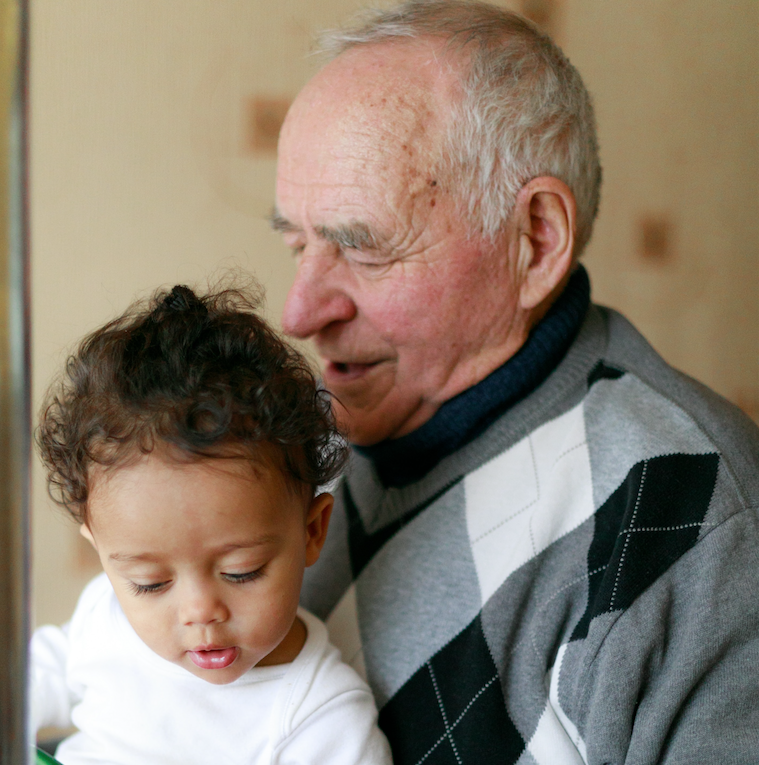
Happy Families
Which families do the children belong to? Being a member of any group is like being a member of a family and often makes us feel happy. Examples: your class at school, swimming class, choir, dance class, football team. Here's a song about being happy - the lyrics are so easy to pick up that they don't really need to be written out!
If You're Happy and You Know It
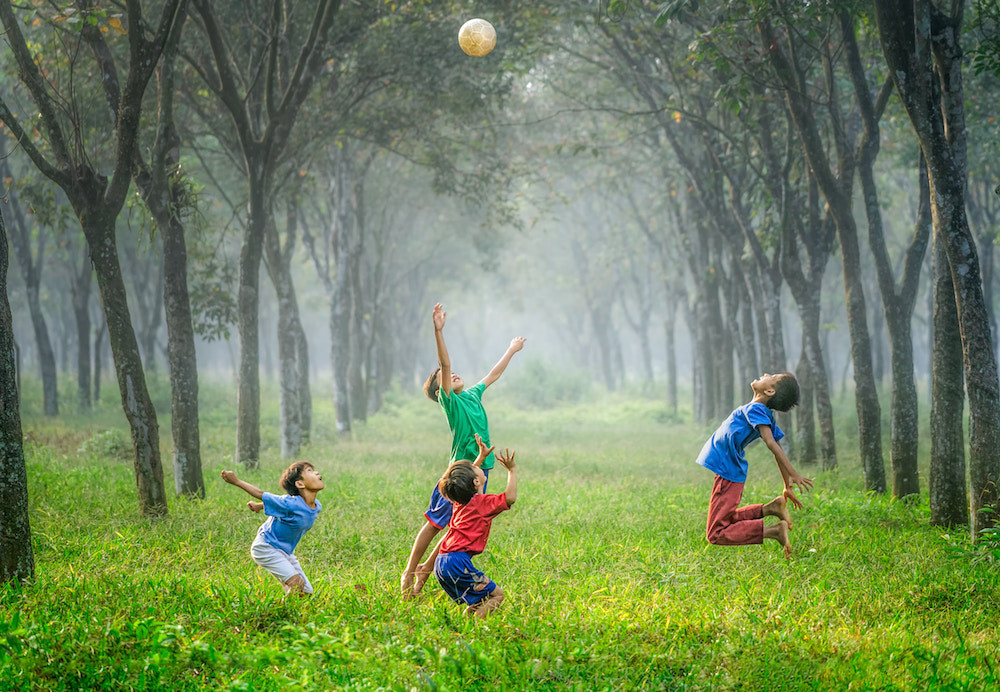
Apusskidusski
In the Seaside and Under the Sea unit there's a traditional Swedish song called I Medelhavet, with an approximate translation of the original words (which happen to begin with a line about sardines!) plus an additional verse that I made up. It's a song that would be ideal for a mother or father to sing to their child, so I've included it here too.
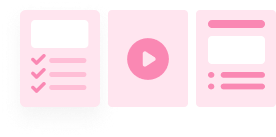
Dad's Dance (structure, pulse)
My dad loved to dance and he would definitely have been up for joining in with this! You'll need to practise it first and you can, of course, make up your own actions as long as you keep the same action for the same part of the song. It works either walking in time on the spot or sitting down (which is easier for co-ordination). Best to have the children facing you in a line so that they can mirror your movements. The music is called Wishi Ta Tuja and it's a Native American water song. This recording is by Ben Noke, my stepson, who is a professional musician, and Luchia's dance demo was filmed by her daddy!
- Here's a plan of the movements
- __
- Intro - Tap legs
- Wishi ta tuja tuja tuja - Wave arms
- Washa de naja heya heya - Roll arms
- Boom boom boom boom Cha cha cha cha - Clap clap clap, then 'Chatty' fingers
- __
- Wishi ta tuja tuja tuja - Wave arms
- Washa de naja heya heya - Roll arms
- Boom boom boom boom Cha cha cha cha - Clap clap clap, then 'Chatty' fingers
- __
- Intro - Tap legs
- Wishi ta tuja tuja tuja - Wave arms
- Washa de naja heya heya - Roll arms
- Boom boom boom boom Cha cha cha cha - Clap clap clap, then 'Chatty' fingers
- __
- Wishi ta tuja tuja tuja - Wave arms
- Washa de naja heya heya - Roll arms
- Boom boom boom boom Cha cha cha cha - Clap clap clap, then 'Chatty' fingers
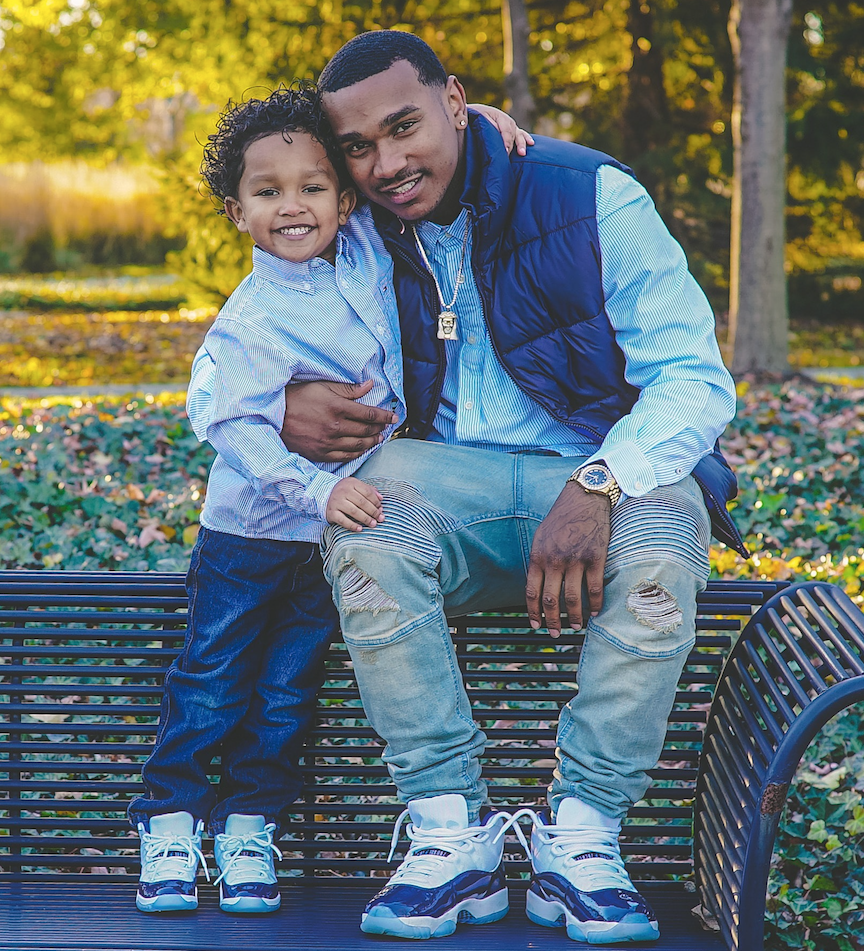
Talking About Music (timbre)
Talking about music is a skill that children need to develop as they learn more about sound and how it is made. In these two videos, we are talking in a small group and I've invited the children to speak freely without raising hands. First, we are talking about the sounds that instruments make prior to exploring a new box of interesting instruments for the first time.
In the second video, the children then chose an instrument each and we compared and contrasted the sounds in terms of timbre, its essential, distinguishing sound, choosing describing words and later suggesting similarities and differences.
Granny's footsteps (timbre, tempo)
'Granny' has several different sounding instruments that she uses for keeping fit! The children decide in advance what movement goes with which sound. Remember that grannies are really not all that old so try a drum for walking, shakers for jogging, little bells for swimming (arm movements).
The teacher is Granny, who plays an instrument, sometimes stopping and starting again. The children move towards her in the agreed way for that instrument, while it is playing. They stop when it stops, and start when it starts again. You can vary how fast you play the instrument and the children have to match the speed.
When all the children are standing on Granny's side of the room, the teacher chooses a different instrument, walks to the other side of the room and the game starts again. When the children know how to play the game, you can swap from one instrument to another, and the children can take turns at being Granny.
If you have limited space, the children can do the actions on the spot.
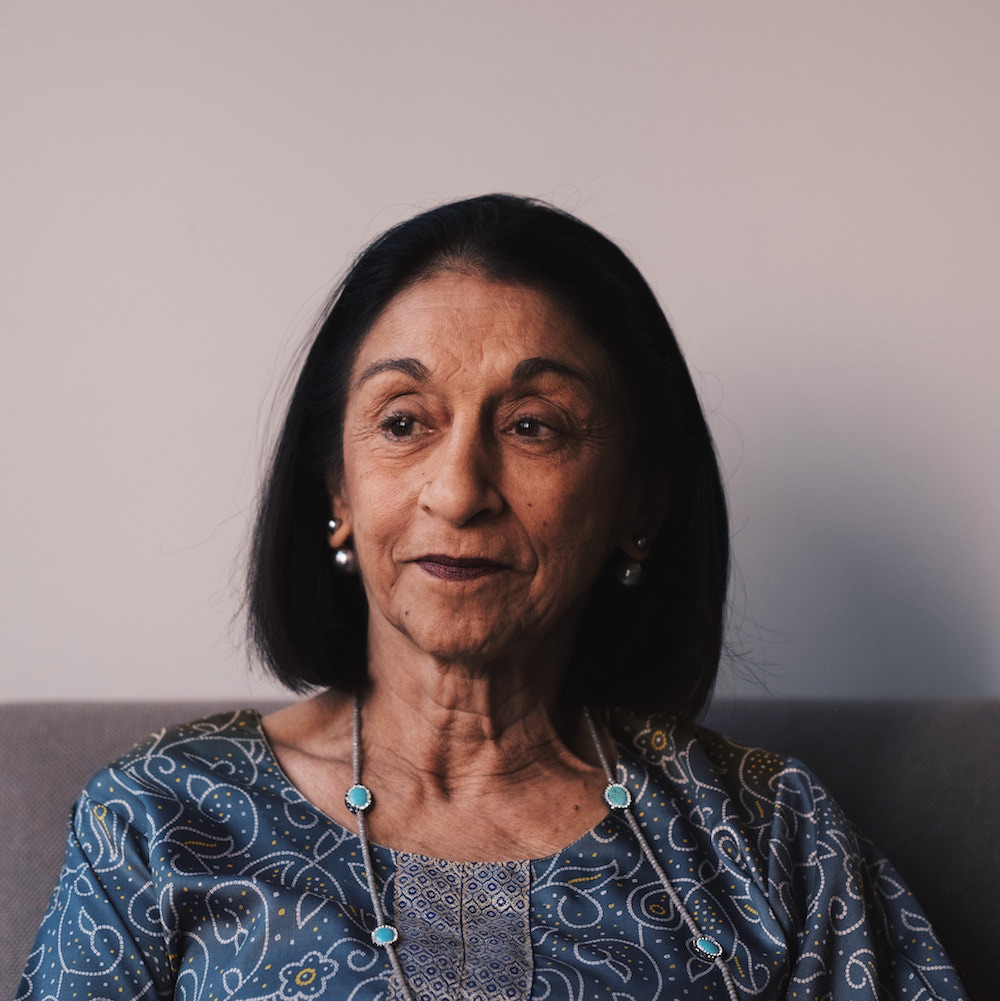
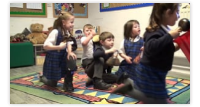
Mary Jones (dynamics, tempo, pitch, structure, texture)
I especially like the way in which the poem shows that children that old people were once young and vigorous, and have a wealth of experiences to share! First of all, teach the children the poem. We may be talking about someone the age of the children's great gran, since Mary is supposed to be really old! This is another chance, after doing a similar activity in the Animals unit, to make music up that reflects moods and movements. The spiral nature of the music curriculum suggests that it's good practice to build on previous musical experiences to enhance creativity, improve skills and further understanding.

- Mary Jones is old now - group 1 (untuned percussion)
- She's sleeping in her chair
- __
- But when she was a young girl - group 2 (untuned percussion)
- She rushed round everywhere
- __
- Mary was a dancer - group 3 (untuned percussion)
- The star of every show
- __
- She climbed the highest mountains - group 4 (tuned percussion going low to high pitch)
- __
- Went skiing in the snow - group 5 (tuned percussion going high to low in pitch)
- __
- Mary Jones is old now - group 6 (untuned percussion)
- She's wiser than you know
- __
- ©Music-Playtime: Arts Enterprise Limited
Divide the class into six small groups then allocate each group a line (or two) of the poem, as shown. Each group has supervised music corner time to choose from a selection of instruments to represent their part of the poem to create the right mood.
Some instruments could be played on their own (thin texture) and some played at the same time (thicker texture).
Do a class performance of the poem, saying each line (or two) then playing the instruments that represent it. Record the performance and let the children appraise using Two Stars and a Wish (what were two good things and what could be improved?). Finally, have another go, incorporating the improvements.
Put it All Away!
Just a reminder that it's the children's responsibility to put the instruments away. Here's a fun way to do it!

A Family of Geese
Geese have families too! Here's a piece for the children to march in time to, either on the spot or round the hall. It's called March of the Geese by the composer Kaneda, played on the piano.

Dance All Around the Room
Who likes dancing in your family? Here's an action song that I made up with Luchia's help. The children do tiptoe movements for the words 'Dance all around the room' and then the other actions, as in the words. If you don't want to have the children dashing around the hall, they could each dance in their own individual hula-hoop. You could either play the track or sing the words and I hope you are going to demonstrate all the actions!
- Dance all around the room
- Turn around, turn around
- Wave your hands up in the air
- Then touch the ground
- __
- Dance all around the room
- Turn around, turn around
- Clap your hands, touch your head
- Then touch the ground
- __
- Dance all around the room
- Turn around, turn around
- Then do a jumping jack
- Then touch the ground
- __
- ©Music-Playtime: Arts Enterprise Limited
Dance or March? (pulse)
If you can walk easily in time to music it's probably a march but if it seems you would need three legs to walk in time it's probably a 3 time dance, like a waltz. (Of course there are also plenty of dances in 4 time, like the tango, where the steps go in fours).
March - First you put the children into pairs and they take it in turns to make a sound, regularly like clockwork:
clap - stamp - clap - stamp - clap - stamp.
Dance - Put the children into threes and now they make a different sound each, regularly like clockwork. Make sure there is no gap in the sound after woo by varying which word the children begin with (sometimes start with stamp or woo instead).
clap - stamp - woo - clap - stamp - woo - clap - stamp - woo
George Meets the Orchestra! (timbre)
The Orchestra is one big musical community made up of smaller families of instruments. Many children of this age will never have seen an orchestra or heard the instruments play separately but this video demonstrates and explains in an immediately engaging way. And you'll LOVE George!

Which Families? (maths link)
Which families do the children belong to? Venn Diagrams are a simple way of showing who is a member of which family group, for instance:
- children
- children with long hair
- children with long hair, wearing red today
Represent this in music too using body sounds! In a circle:
- all children - walk on the spot
- children with long hair - walk and also clap their hands
- children with long hair, wearing red – walk, clap and say the words, wearing red, wearing red.
(If the school has a uniform you'll obviously need to change 'wearing red' to something different.)
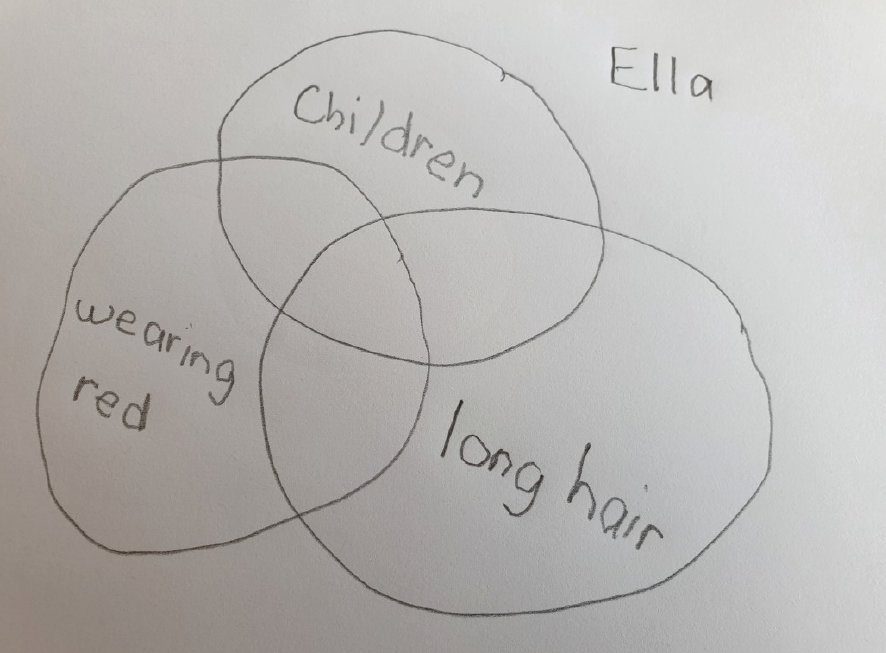
Clocks Families (language and literacy link)
Everyone say this poem rhythmically, getting louder and louder:
- Little clocks have quiet ticks
- The clock on the wall is louder
- Grandfather clock has a loud tick tock
- He's bigger and he's prouder
Make a clock (art and craft link)
This is what you need:
- one white paper plate and one coloured plate
- draw dots on the coloured plate as a guide to where the numbers will go
- foam numbers
- a dark marker or permanent marker pen
- glue stick
- coloured paper
How to make the clock
- Glue the two plates together one on top of the other, so the white plate makes an outer rim and the clock face is coloured.
- Stick the numbers on the clock face in the proper places.
- Optionally, write out the minutes with the marker.
- Cut out the hour and minute hands and fasten them to the centre of the plate with a paper fastener.
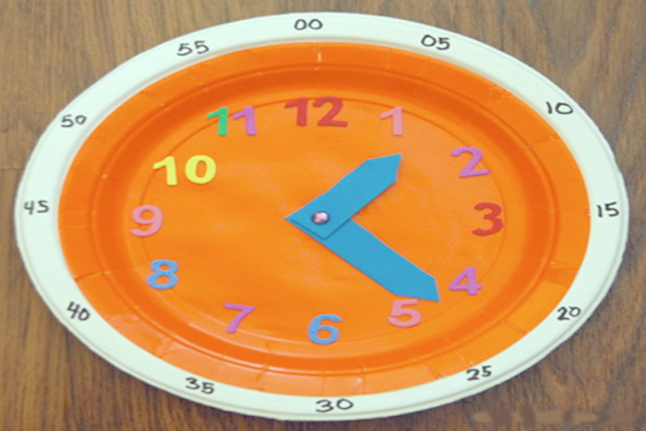
Music While You Work
Listen while you work to The Viennese Musical Clock from the Hary Janos Suite by Kodaly.
Learn the Dance (structure)
Learning the clock dance is great fun and it's a good way of explaining the structure of the music through movement.

Who's in Your Family?
The point of the song is that we have all sorts of different families and that pets may be included too. I like children to use their solo sing-song voice without feeling unselfconscious so I never correct the pitch of the singing in this context. This was the first attempt, as you might have guessed!
My Granny Gave Me (rhythm, pulse, literacy link)
This is an alphabet game that can be played on successive days, choosing new letters each day. This game works well as an activity for a groups of three to five children but you could also do it in a big circle with the whole class if the children take turns. The children in the group take turns to say, 'My granny gave me a ....' so, before the game can start, ask for ideas about what granny 'gave me' and make sure every child has their phrase ready. Straight after the word such as Anteater, everyone in the group claps its rhythm then the next child continues with their words, without a pause. You may like to start with only three things that granny gave me, and then build up to four or five. The words needs to be rhythmical so tap the pulse on knees or use a drum to keep the pulse. After all the children in the group have said what granny gave them, they all say, 'And that's all!'
- Child 1 - My granny gave me an Anteater (clap clap clap)
- Child 2 - My granny gave me a Bear (clap)
- Child 3 - My granny gave me a Cam-el (clap clap)
- Child 4 - My granny gave me a Duck (clap)
- Child 5 - My granny gave me an El-e-phant (clap clap clap)
- Child 1 - My Granny gave me an Anteater (clap clap clap), Child 2 - bear (clap), Child 3 - Cam-el (clap clap), Child 4 - Duck (clap), Child 5 - El-e-phant (clap clap clap)
- Everyone - And that's all!


Ye Canna Shove Your Granny Off a Bus!
I soon remembered this song with Amitie's help! This video demonstrates one of the reasons why I tend not to use accompaniments for singing - the spontaneity here is delightful and the moment could not have waited while we found an accompaniment!
Grandma's Action Chant
It's best to teach chants by rote, but some children may enjoy reading the words at first. There are actions for each line.
- These are grandma’s glasses (make circles around eyes with fingers)
- This is grandma’s hat (use both hands to make a hat shape on head)
- This is the way she folds her hands (put one hand over the other)
- And puts them on her lap (put hands in lap)
- These are grandad’s glasses (make circles around eyes with fingers)
- This is Grandad’s hat (use both hands to make a hat shape on head)
- This is the way he folds his arms (fold arms)
- And THAT IS THAT!

Happy Families
Which families do the children belong to? Being a member of any group is like being a member of a family and often makes us feel happy. Examples: your class at school, swimming class, choir, dance class, football team. Here's a song about being happy - the lyrics are so easy to pick up that they don't really need to be written out!
If You're Happy and You Know It

Apusskidusski
In the Seaside and Under the Sea unit there's a traditional Swedish song called I Medelhavet, with an approximate translation of the original words (which happen to begin with a line about sardines!) plus an additional verse that I made up. It's a song that would be ideal for a mother or father to sing to their child, so I've included it here too.

Dad's Dance (structure, pulse)
My dad loved to dance and he would definitely have been up for joining in with this! You'll need to practise it first and you can, of course, make up your own actions as long as you keep the same action for the same part of the song. It works either walking in time on the spot or sitting down (which is easier for co-ordination). Best to have the children facing you in a line so that they can mirror your movements. The music is called Wishi Ta Tuja and it's a Native American water song. This recording is by Ben Noke, my stepson, who is a professional musician, and Luchia's dance demo was filmed by her daddy!
- Here's a plan of the movements
- __
- Intro - Tap legs
- Wishi ta tuja tuja tuja - Wave arms
- Washa de naja heya heya - Roll arms
- Boom boom boom boom Cha cha cha cha - Clap clap clap, then 'Chatty' fingers
- __
- Wishi ta tuja tuja tuja - Wave arms
- Washa de naja heya heya - Roll arms
- Boom boom boom boom Cha cha cha cha - Clap clap clap, then 'Chatty' fingers
- __
- Intro - Tap legs
- Wishi ta tuja tuja tuja - Wave arms
- Washa de naja heya heya - Roll arms
- Boom boom boom boom Cha cha cha cha - Clap clap clap, then 'Chatty' fingers
- __
- Wishi ta tuja tuja tuja - Wave arms
- Washa de naja heya heya - Roll arms
- Boom boom boom boom Cha cha cha cha - Clap clap clap, then 'Chatty' fingers

Talking About Music (timbre)
Talking about music is a skill that children need to develop as they learn more about sound and how it is made. In these two videos, we are talking in a small group and I've invited the children to speak freely without raising hands. First, we are talking about the sounds that instruments make prior to exploring a new box of interesting instruments for the first time.
In the second video, the children then chose an instrument each and we compared and contrasted the sounds in terms of timbre, its essential, distinguishing sound, choosing describing words and later suggesting similarities and differences.
Granny's footsteps (timbre, tempo)
'Granny' has several different sounding instruments that she uses for keeping fit! The children decide in advance what movement goes with which sound. Remember that grannies are really not all that old so try a drum for walking, shakers for jogging, little bells for swimming (arm movements).
The teacher is Granny, who plays an instrument, sometimes stopping and starting again. The children move towards her in the agreed way for that instrument, while it is playing. They stop when it stops, and start when it starts again. You can vary how fast you play the instrument and the children have to match the speed.
When all the children are standing on Granny's side of the room, the teacher chooses a different instrument, walks to the other side of the room and the game starts again. When the children know how to play the game, you can swap from one instrument to another, and the children can take turns at being Granny.
If you have limited space, the children can do the actions on the spot.


Mary Jones (dynamics, tempo, pitch, structure, texture)
I especially like the way in which the poem shows that children that old people were once young and vigorous, and have a wealth of experiences to share! First of all, teach the children the poem. We may be talking about someone the age of the children's great gran, since Mary is supposed to be really old! This is another chance, after doing a similar activity in the Animals unit, to make music up that reflects moods and movements. The spiral nature of the music curriculum suggests that it's good practice to build on previous musical experiences to enhance creativity, improve skills and further understanding.

- Mary Jones is old now - group 1 (untuned percussion)
- She's sleeping in her chair
- __
- But when she was a young girl - group 2 (untuned percussion)
- She rushed round everywhere
- __
- Mary was a dancer - group 3 (untuned percussion)
- The star of every show
- __
- She climbed the highest mountains - group 4 (tuned percussion going low to high pitch)
- __
- Went skiing in the snow - group 5 (tuned percussion going high to low in pitch)
- __
- Mary Jones is old now - group 6 (untuned percussion)
- She's wiser than you know
- __
- ©Music-Playtime: Arts Enterprise Limited
Divide the class into six small groups then allocate each group a line (or two) of the poem, as shown. Each group has supervised music corner time to choose from a selection of instruments to represent their part of the poem to create the right mood.
Some instruments could be played on their own (thin texture) and some played at the same time (thicker texture).
Do a class performance of the poem, saying each line (or two) then playing the instruments that represent it. Record the performance and let the children appraise using Two Stars and a Wish (what were two good things and what could be improved?). Finally, have another go, incorporating the improvements.
Put it All Away!
Just a reminder that it's the children's responsibility to put the instruments away. Here's a fun way to do it!

A Family of Geese
Geese have families too! Here's a piece for the children to march in time to, either on the spot or round the hall. It's called March of the Geese by the composer Kaneda, played on the piano.

Dance All Around the Room
Who likes dancing in your family? Here's an action song that I made up with Luchia's help. The children do tiptoe movements for the words 'Dance all around the room' and then the other actions, as in the words. If you don't want to have the children dashing around the hall, they could each dance in their own individual hula-hoop. You could either play the track or sing the words and I hope you are going to demonstrate all the actions!
- Dance all around the room
- Turn around, turn around
- Wave your hands up in the air
- Then touch the ground
- __
- Dance all around the room
- Turn around, turn around
- Clap your hands, touch your head
- Then touch the ground
- __
- Dance all around the room
- Turn around, turn around
- Then do a jumping jack
- Then touch the ground
- __
- ©Music-Playtime: Arts Enterprise Limited
Dance or March? (pulse)
If you can walk easily in time to music it's probably a march but if it seems you would need three legs to walk in time it's probably a 3 time dance, like a waltz. (Of course there are also plenty of dances in 4 time, like the tango, where the steps go in fours).
March - First you put the children into pairs and they take it in turns to make a sound, regularly like clockwork:
clap - stamp - clap - stamp - clap - stamp.
Dance - Put the children into threes and now they make a different sound each, regularly like clockwork. Make sure there is no gap in the sound after woo by varying which word the children begin with (sometimes start with stamp or woo instead).
clap - stamp - woo - clap - stamp - woo - clap - stamp - woo
George Meets the Orchestra! (timbre)
The Orchestra is one big musical community made up of smaller families of instruments. Many children of this age will never have seen an orchestra or heard the instruments play separately but this video demonstrates and explains in an immediately engaging way. And you'll LOVE George!

Which Families? (maths link)
Which families do the children belong to? Venn Diagrams are a simple way of showing who is a member of which family group, for instance:
- children
- children with long hair
- children with long hair, wearing red today
Represent this in music too using body sounds! In a circle:
- all children - walk on the spot
- children with long hair - walk and also clap their hands
- children with long hair, wearing red – walk, clap and say the words, wearing red, wearing red.
(If the school has a uniform you'll obviously need to change 'wearing red' to something different.)

Clocks Families (language and literacy link)
Everyone say this poem rhythmically, getting louder and louder:
- Little clocks have quiet ticks
- The clock on the wall is louder
- Grandfather clock has a loud tick tock
- He's bigger and he's prouder
Make a clock (art and craft link)
This is what you need:
- one white paper plate and one coloured plate
- draw dots on the coloured plate as a guide to where the numbers will go
- foam numbers
- a dark marker or permanent marker pen
- glue stick
- coloured paper
How to make the clock
- Glue the two plates together one on top of the other, so the white plate makes an outer rim and the clock face is coloured.
- Stick the numbers on the clock face in the proper places.
- Optionally, write out the minutes with the marker.
- Cut out the hour and minute hands and fasten them to the centre of the plate with a paper fastener.

Music While You Work
Listen while you work to The Viennese Musical Clock from the Hary Janos Suite by Kodaly.
Learn the Dance (structure)
Learning the clock dance is great fun and it's a good way of explaining the structure of the music through movement.
